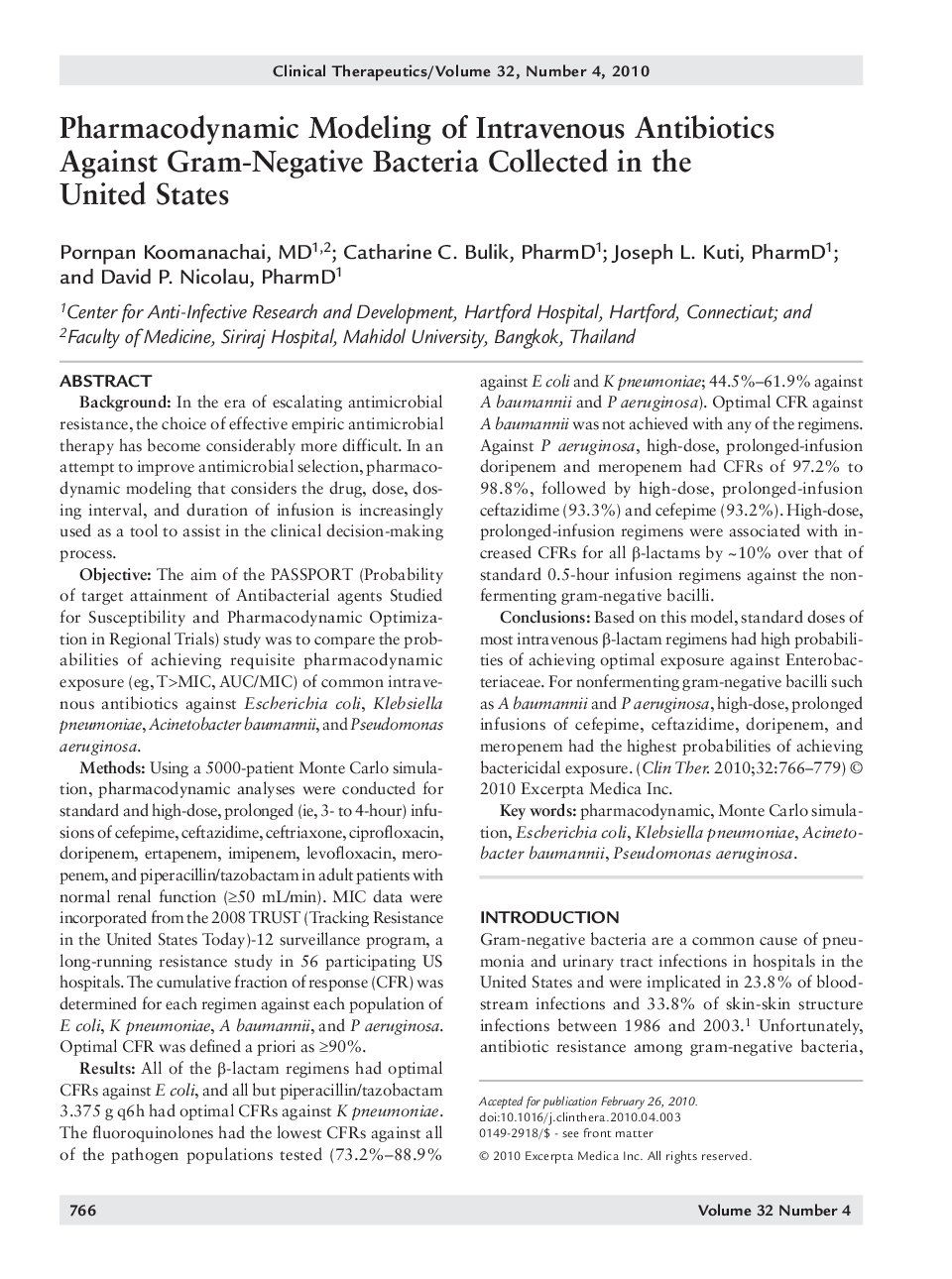| کد مقاله | کد نشریه | سال انتشار | مقاله انگلیسی | نسخه تمام متن |
|---|---|---|---|---|
| 2528876 | 1119990 | 2010 | 14 صفحه PDF | دانلود رایگان |

Background: In the era of escalating antimicrobial resistance, the choice of effective empiric antimicrobial therapy has become considerably more difficult. In an attempt to improve antimicrobial selection, pharmacodynamic modeling that considers the drug, dose, dosing interval, and duration of infusion is increasingly used as a tool to assist in the clinical decision-making process.Objective: The aim of the PASSPORT (Probability of target attainment of Antibacterial agents Studied for Susceptibility and Pharmacodynamic Optimization in Regional Trials) study was to compare the probabilities of achieving requisite pharmacodynamic exposure (eg, T>MIC, AUC/MIC) of common intravenous antibiotics against Escherichia coli, Klebsiella pneumoniae, Acinetobacter baumannii, and Pseudomonas aeruginosa.Methods: Using a 5000-patient Monte Carlo simulation, pharmacodynamic analyses were conducted for standard and high-dose, prolonged (ie, 3-to 4-hour) infusions of cefepime, ceftazidime, ceftriaxone, ciprofloxacin, doripenem, ertapenem, imipenem, levofloxacin, meropenem, and piperacillin/tazobactam in adult patients with normal renal function (≥50 mL/min). MIC data were incorporated from the 2008 TRUST (Tracking Resistance in the United States Today)-12 surveillance program, a long-running resistance study in 56 participating US hospitals. The cumulative fraction of response (CFR) was determined for each regimen against each population of E coli, K pneumoniae, A baumannii, and P aeruginosa. Optimal CFR was defined a priori as ≥90%.Results: All of the β-lactam regimens had optimal CFRs against E coli, and all but piperacillin/tazobactam 3.375 g q6h had optimal CFRs against K pneumoniae. The fluoroquinolones had the lowest CFRs against all of the pathogen populations tested (73.2%–88.9%against E coli and K pneumortfae; 44.5 %–61.9 % against A baumannii and P aeruginosa). Optimal CFR against A baumannii was not achieved with any of the regimens. Against P aeruginosa, high-dose, prolonged-infusion doripenem and meropenem had CFRs of 97.2% to 98.8%, followed by high-dose, prolonged-infusion ceftazidime (93.3%) and cefepime (93.2%). High-dose, prolonged-infusion regimens were associated with increased CFRs for all (β-lactams by ~10% over that of standard 0.5-hour infusion regimens against the nonfermenting gram-negative bacilli.Conclusions: Based on this model, standard doses of most intravenous (β-lactam regimens had high probabilities of achieving optimal exposure against Enterobacteriaceae. For nonfermenting gram-negative bacilli such as A baumannii and P aeruginosa, high-dose, prolonged infusions of cefepime, ceftazidime, doripenem, and meropenem had the highest probabilities of achieving bactericidal exposure.
Journal: Clinical Therapeutics - Volume 32, Issue 4, April 2010, Pages 766-779